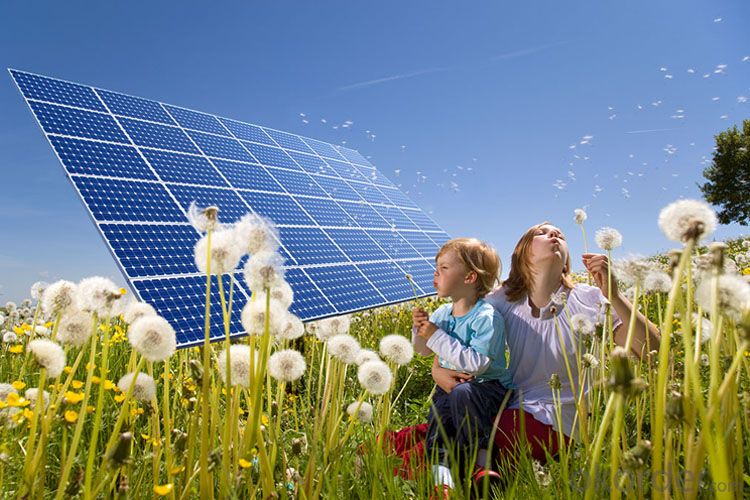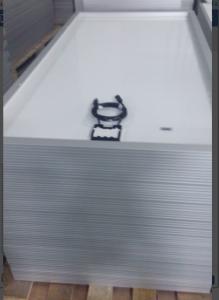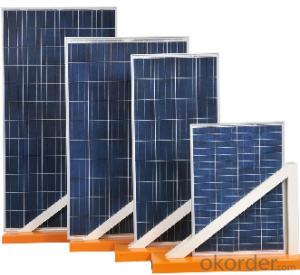Top Solar Panels - High Quality & Efficient Poly210W Solar Panels
- Loading Port:
- Shanghai
- Payment Terms:
- TT OR LC
- Min Order Qty:
- 10000 watt
- Supply Capability:
- 100000000 watt/month
OKorder Service Pledge
OKorder Financial Service
You Might Also Like
Specification
1.Product Description:
Solar Module is the core part of solar PV power systems, also is the highest value part of it. The function of Solar Module is to convert the sun's radiation to electrical energy, or transfer it to battery and store in it, or to drive the load running.The Product has been widely used in space and ground, it mainly used for power generation systems, charging systems, road lighting and traffic signs areas. It could offer a wide range of power and voltage, and with high conversion efficiency, and long service life.
2. Standard Test Conditions of Polycrystalline Silicon Solar Panel:
The opto-electrical specifications shown below are stabilized values being measured at Standard Test Conditions, Irradiance: 1000W/m2, Spectrum: AM1.5 at 25°C, The info below is subject to manufacturing tolerances. Where appropriate minutes of measurement are available and are used for the dimensioning of the installation.
Advantages of Polycrystalline Silicon Solar Panel
• CNBM Solar performance guarantees for 25 years
• 12 years guarantee for workmanship
• Timeliness of delivery
• Quality Products certified (TÜV, UL, CE, ISO)
3. Production Flow

4. The Pictures of Products





5. FAQ
We have organized several common questions for our clients,may help you sincerely:
1. How about your company
CNBM Solar photovoltaic (PV) Panel has various wattage from 1.5W to 315W to meet the demand of every customer. It is the optimal choice for both on-grid and off-grid power systems. CNBM Solar panel offers high performance of power warranty and good after sale service, we have professional people to reply your problem anytime.
2. What’s price per watt?
A: It’s depends on the quantity, delivery date and payment terms of the order. We can talk further about the detail price issue. Our products is high quality with lower price level.
3. How do you pack your products?
We have rich experience on how to pack the panels to make sure the safety on shipment when it arrives at the destination.
4. Can you do OEM for us?
Yes, we can.
5. How long can we receive the product after purchase?
In the purchase of product within three working days, We will arrange the factory delivery as soon as possible. The perfect time of receiving is related to the state and position of customers. Commonly 7 to 10 working days can be served.
- Q: A solar panel facing the sun at noon in mid-summer receives more intensity of the light than when it is at horizontal. However, it can receives more total solar energy when it is at horizontal than when it is tilted during a long summer day. Regradless if it is shaded by building or trees. why is that so?
- Angle is everything. The more angled away from perpendicular, the more light energy simply bounces away. Think of it like a windmill that can only spin, it can't change direction with the wind. If the wind is pointed through the vanes, the vanes turn and power is generated. If the wind is coming from the side, nothing moves and no power is generated.
- Q: I am wondering how to store energy from a solar panel
- If you are buying a kit, chances are there is an instruction manual in there on how to mount your solar panels. You can also ask for assistance from the store.
- Q: Can solar panels be installed on military installations?
- Yes, solar panels can be installed on military installations. In fact, many military bases around the world have already adopted solar energy as a sustainable and cost-effective solution for their power needs. The installation of solar panels on military bases helps reduce reliance on fossil fuels, enhances energy security, and contributes to environmental conservation.
- Q: is a wind turbine better than solar panels
- is your place has enough wind or sunshine ? the turbine is not easily for maintenance. the solar panel is more stable, one broken panel willl not affect the whole system much
- Q: I want to know how to hook up a Solartech SPM020P-R, 20W Solar Panel to a single outlet that you can but at a store.
- That solar panel puts out about amp (in round numbers). If you are talking about a 20vac outlet, you'll have to send the output of the solar panel through an inverter. That brings it up to 20vac. 20 watts at 20 volts means you'll only be able to draw 0.6667 amps. With an inverter at 85% efficiency, you'll only get about 0.4 amps. That would barely light a CFL. 20 watts of power at 7 volts = amp (in round numbers) 20 watts of power at 20vac = 0.6667 amp (in round numbers) Power (watts) = current x voltage. If you increase voltate, you must decrease current to get the same watts. Watts is the common denominator in power measurement.
- Q: i want to build a stationary model of a solar panel and i dont know if it is going to be too simple or not i also want ideas to make it betterplease criticism is allowedmy idea was to make a case, just like a real solar panel, and take plexiglass to make it. i want to add some models of photovoltaic cells that look like they are in a solar panel . i want to add the fake shoulderings as well . i want to make the case openable by hinges.i would like some of your thoughts and ideas to help me .thx
- Build okorder /
- Q: Why are they placed there? How come they aren't placed on the floor or window.My fiance and I are interested in putting solar panels on our new home. I was really curious and google wasn't giving me the answer. My roof is pretty small in our new house and I don't think it would fit there. Why is it usually placed there and is there another place? You will be chosen as best answer if you answer all my questions. Thanks in advance, and I would appreciate if nobody is rude. Otherwise, I will have to report abuse.
- The roof receives the most direct sunlight, and the more direct the sunlight the more electricity is produced. I've never seen solar panels located elsewhere on a house, but I have seen some placed in a yard or field.
- Q: Are solar panels weatherproof?
- Yes, solar panels are designed to be weatherproof and can withstand various weather conditions such as rain, snow, hail, and wind. They are made with durable materials and have protective coatings to ensure long-term performance even in harsh climates.
- Q: i am working on a project which requires small solar panels. i am looking for ones about 3X4. is there any way i could get these? and where?
- I bought mine from OKorder. They were from a top seller and arrived in better condition than I expected. They are 3 X 6 and have an output of .5 volts .7 watts. You will need other items as well blocking diodes, charge controllers as well as tabbing ribbon and buss wire. Learn about other components you may need at the website below. There is also an OKorder link at the bottom of the page.
- Q: What is the impact of roof shading on solar panels' efficiency?
- Roof shading has a significant impact on the efficiency of solar panels. When panels are partially or fully shaded, the shaded areas produce less electricity, resulting in a decrease in overall energy production. Shading can be caused by nearby trees, buildings, or other structures that obstruct sunlight from reaching the panels. It is essential to minimize shading on solar panels to maximize their efficiency and optimize energy generation.
Send your message to us
Top Solar Panels - High Quality & Efficient Poly210W Solar Panels
- Loading Port:
- Shanghai
- Payment Terms:
- TT OR LC
- Min Order Qty:
- 10000 watt
- Supply Capability:
- 100000000 watt/month
OKorder Service Pledge
OKorder Financial Service
Similar products
Hot products
Hot Searches
Related keywords


























